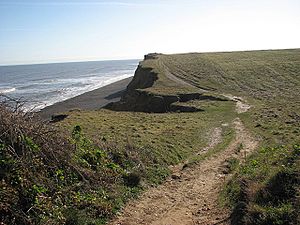Weybourne Cliffs facts for kids
| Site of Special Scientific Interest | |
 |
|
| Area of Search | Norfolk |
|---|---|
| Coordinates | 52°56′46″N 1°10′23″E / 52.946°N 1.173°E |
| Interest | Biological Geological |
| Area | 40.9 hectares (101 acres) |
| Notification | 1985 |
| Location map | Magic Map |
Weybourne Cliffs is a special place in Norfolk, England. It's known for its amazing natural features. This area is officially called a Site of Special Scientific Interest (SSSI) because it has important wildlife and unique rocks. It covers about 40.9 hectares (101 acres) of land. You can find it near Weybourne, west of Sheringham. The beach here is open for everyone to visit and enjoy.
Contents
What Makes Weybourne Cliffs Special?
Weybourne Cliffs is a very important location for both nature and science. It's recognized as a Site of Special Scientific Interest (SSSI) because it protects rare plants, animals, and geological features. It's also part of the Norfolk Coast Area of Outstanding Natural Beauty, which means it's a beautiful landscape that is protected for everyone to enjoy.
A Look Back in Time: Ancient Rocks and Fossils
The cliffs at Weybourne are like a giant history book made of rock. They show us what the Earth was like during a time called the Pleistocene epoch. This was a long, long time ago, between 2.6 million and 11,700 years ago, when ice ages shaped much of the world.
The Weybourne Crag Formation
Weybourne Cliffs is the main place where scientists first studied a special layer of rock called the Weybourne Crag Formation. This rock layer is super important because it helps us understand a specific warm period in Earth's history called the Pastonian Stage.
Discovering Ancient Sea Creatures
For over 200 years, scientists have been studying the fossils found in these cliffs. These fossils are mostly from marine molluscs, which are sea creatures like snails and clams that lived in the ocean millions of years ago. By studying these fossils, scientists can learn about the ancient environments and climates of our planet.
Home for Sand Martins
Besides its amazing geology, Weybourne Cliffs is also important for its wildlife. The tall, sandy cliffs provide a perfect home for colonies of sand martins. These small birds dig tunnels into the soft cliffs to build their nests. It's a great place to see them flying around and raising their young.

